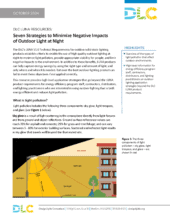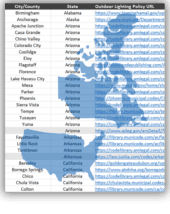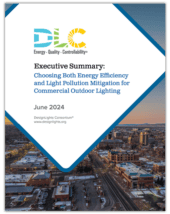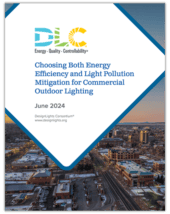LUNA

Seven Strategies to Minimize Negative Impacts of Outdoor Light at Night
This resource provides high-level application strategies that go beyond the LUNA product requirements for energy efficiency program staff, contractors, distributors, and lighting practitioners who are interested in using outdoor lighting that is both energy efficient and reduces light pollution.
Key Takeaways
- Overview of the types of light pollution that affect outdoor environments.
- High-level information for energy efficiency program staff, contractors, distributors, and lighting practitioners on outdoor lighting application strategies beyond the DLC LUNA product requirements.

Application Guidance for LUNA V1.0
This resource explains common misunderstandings of the LUNA Technical Requirements that impact application review and timing and provides information about specific items to pay particular attention to on the application form.
Key Takeaways
- Detailed information on how to ensure a complete LUNA application.

Outdoor Lighting Ordinances Map Data
Download the data from our outdoor lighting ordinances map. Last updated in June 2024.
Key Takeaways
- Outdoor Lighting Ordinances for Mitigating Light Pollution in the US and Canada

Executive Summary: Choosing Both Energy Efficiency and Light Pollution Mitigation for Commercial Outdoor Lighting
There is a perception that, in a commercial retrofit setting, light pollution mitigating LEDs are less efficient and more costly than energy efficient LEDs, but in some cases you can have the best of both worlds. The DLC commissioned a study to research the impacts of LED applications that are both energy efficient and minimize light pollution as compared with products focused solely on energy efficiency. This executive summary provides an overview of the results of the research.
Key Takeaways
- An overview of how utilities can help municipalities achieve their energy efficiency and decarbonization targets while protecting ecosystems and preserving the night sky for future generations.

Choosing Both Energy Efficiency and Light Pollution Mitigation for Commercial Outdoor Lighting
There is a perception that, in a commercial retrofit setting, light pollution mitigating LEDs are less efficient and more costly than energy efficient LEDs, but in some cases you can have the best of both worlds. The DLC commissioned a study to research the impacts of LED applications that are both energy efficient and minimize light pollution as compared with products focused solely on energy efficiency. The study includes analysis of the impact on ROI, annual energy use, and energy costs.
Key Takeaways
- Learn how utilities can help municipalities achieve their energy efficiency and decarbonization targets while protecting ecosystems and preserving the night sky for future generations.
- Discover how municipalities can meet their energy goals while reducing the harm caused by excessive outdoor lighting.
- Learn new ways to calculate ROI for responsible outdoor lighting.

LUNA V1.0 Technical Requirements Guidance for Submitters
This companion to the LUNA V1.0 Technical Requirements provides a high-level summary of the key LUNA requirements that differ from the SSL V5.1 requirements.
Key Takeaways
- Summary of information needed to create a complete LUNA application.
- Eligible and non-eligible product types under LUNA.
- Required supporting documentation for LUNA applications.
Still need help?
© 2025 DesignLights Consortium. The DesignLights Consortium is a project of Efficiency Forward, Inc., a non-profit 501(c)3 organization. Privacy Policy Terms of Use

